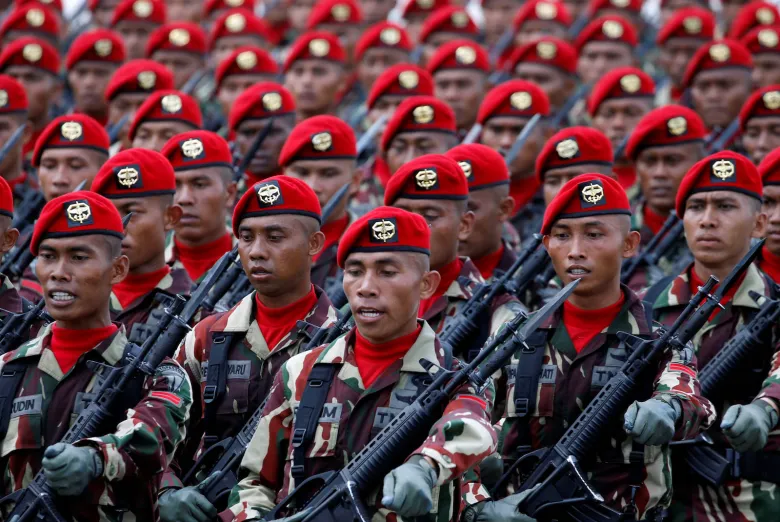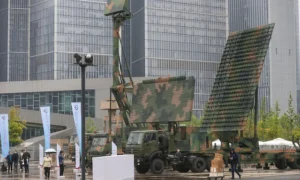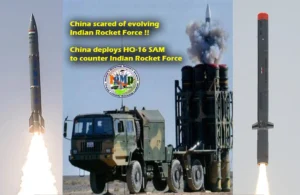But this focus on personnel has come at the expense of developing Indonesia’s platform-heavy maritime defence and security capabilities.
In 2014, the Indonesian military had 3,95,500 active personnel. By 2024, the number had grown to 4,04,500.
A 2021 poll by Kompas revealed that 62.3 per cent of respondents were interested in joining the Indonesian National Armed Forces (TNI). The top reasons given were the desire to defend the country (49.9 per cent), make their family proud (33.5 per cent) and secure a stable future (16.2 per cent). Interest in military careers in Indonesia is partly driven by the continued influence and authority of the Indonesian National Armed Forces.
Military influence
Efforts during the Reform era after 1998 aimed to reduce the military’s socio-political role, which was prominent during Suharto’s New Order. However, under President Joko Widodo’s administration, the military has regained significant influence, with the TNI being involved in various non-military areas, such as COVID-19 management. Jokowi’s preference for military figures over civilian leadership has reinforced the TNI’s role in Indonesia’s economic, political and social spheres. Widodo has twice appointed military retirees, Ryamizard Ryacudu and Prabowo Subianto, as defence ministers, marking a shift from the Reform era when defence ministers were civilians. Additionally, Jokowi placed military figures in other traditionally civilian cabinet roles, including health minister Terawan Agus Putranto (2019-20), religious minister Fachrul Razi (2019-20), and agrarian ministers Hadi Tjahjanto (2022-24) and Agus Harimurti Yudhoyono (2024).
Chief of Presidential Staff Moeldoko (2018-24) is also from a military background. In 2023, around 3,000 active-duty soldiers served in at least 16 government ministries and agencies.
The military’s expanding role in economic, political and social life may soon be formalised, as a bill revising the TNI Law entered parliamentary deliberation in May 2024. The proposed law would allow active-duty personnel to hold positions in civilian government ministries and agencies.
‘Dual function’
Critics have likened it to a return of the “dwifungsi” (dual function) doctrine from the New Order era when the military held both security and political-economic roles. However, TNI Commander General Agus Subiyanto responded by stating that the TNI is no longer dual-function, but has become “multifungsi” (multi-function).
Unlike many other militaries, the TNI does not have an “up or out” promotion system, in which personnel must advance in rank within a set period or face discharge. Instead, the TNI law mandates promotions every 4-5 years under specific conditions. This has led to “promotional logjams”, with too many officers for too few available positions.
Rather than reforming personnel policies to address this issue, Jokowi appointed military personnel to civilian government roles and expanded the army’s territorial command structure.
During Widodo’s administration, the TNI has seen several expansions in operational commands. Some of these expansions have clear strategic justifications.
For example, the Navy’s 3rd Fleet Command and the Air Force’s 3rd Air Operations Command were both established to enhance coverage of eastern Indonesia’s maritime and airspace areas.
Additionally, the 2019 establishment of the Joint Regional Defense Command, which integrates TNI bases across the country, aims to improve joint interoperability among the TNI service branches, enhancing their ability to operate cohesively and efficiently across Indonesia’s vast territory.
Internal interests
Some of the recent expansions in the TNI appear to be driven more by internal interests than by strategic necessity. For example, the Army plans to establish 22 new military regional commands, increasing the total to 37. Army Chief of Staff General Maruli Simanjuntak justified this move by citing the need to match the number of regional police commands, which are present in every province.
However, while it makes sense for the police to have a presence in every province given their role in maintaining public security and order, there is no clear need for the Army to have the same number of commands.
The Indonesian Army, being more personnel-heavy than other branches, faces increased personnel demands with the expansion of its territorial command structure.
This adds pressure on the defence budget, which typically allocates nearly 50 per cent to personnel expenses. In contrast, capital spending only accounts for about 30 per cent, and goods spending around 20 per cent.
Expanding personnel requirements could further reduce funds for capital and goods expenditures, which are crucial for the Navy and Air Force, both of which are platform-intensive and in urgent need of development.
In 2014, Widodo introduced the “Global Maritime Fulcrum” vision, aimed at enhancing Indonesia’s maritime governance and defence capabilities.
Although many observers now view the Global Maritime Fulcrum as a “dead” policy due to a lack of attention during Widodo’s second term, it did help establish a foundation for improving Indonesia’s maritime governance. Despite some progress in modernising the Navy, much remains to be done to establish an ideal maritime defence and security posture.
The Navy’s advancements and modernisation across various sea power variables are still modest compared to naval expansions in other similarly ranked countries.
Additionally, the Maritime Security Agency (Bakamla), responsible for security and safety patrols in Indonesian waters, continues to struggle with limited and constrained capabilities.









